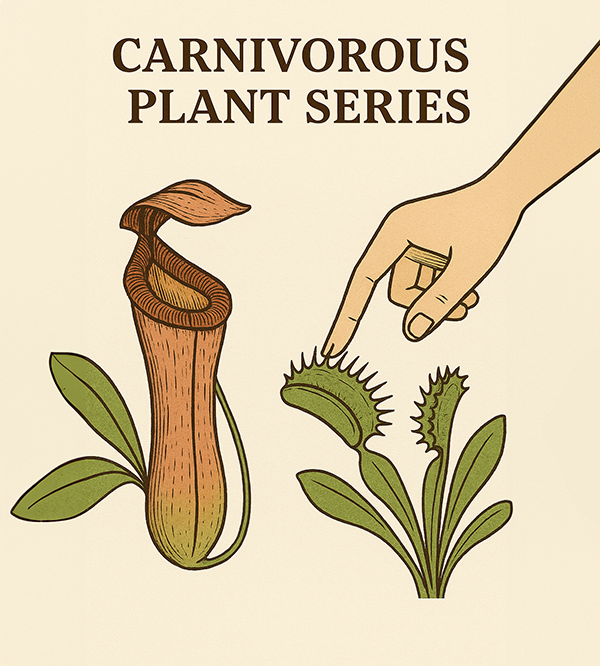
A Beginner's Guide to Carnivorous Plants
Bug-Catching Beauties: A Beginner's Guide to Carnivorous Plants
Hi there! Emily here with Rooted in Kaufman, and if you’ve ever been curious about those strange, bug-munching plants on our shelves, this one’s for you. We just wrapped up a three-part video series on carnivorous plants, and now we’ve got all that juicy info in one place. From how they work to how to care for them (without stressing them out), this blog post will walk you through the essentials of owning one of these fascinating plants.
Part 1: What Makes a Plant Carnivorous?
Carnivorous plants get their nutrients not from the soil, but from the bugs they trap and digest. Two of the most iconic types are:

-
Pitcher Plants: These have pitcher-shaped leaves that you fill with water about halfway. Bugs crawl in, thinking it’s just a sip of water, and can’t crawl back out. The plant then digests the bug and leaves behind only the exoskeleton.

- Venus Flytraps: Each “mouth” contains tiny trigger hairs. When enough of these hairs are touched, the trap snaps shut. It takes about a week to digest the bug and reopen. You might even see little insect remains inside!
Fun fact: Venus flytraps and some pitcher plants are actually native to the Carolinas and can be grown as perennials in outdoor bog gardens here in Texas. Just make sure to bring the non-native varieties inside during the colder months.
And stay tuned—sundews and butterworts are coming soon to Rooted in Kaufman! These sticky-leafed carnivores are fantastic for catching gnats.


Part 2: Caring for Carnivorous Plants
People often think carnivorous plants are difficult, but the truth is, they just have specific needs:
1. Water Quality Matters
Carnivorous plants do not want nutrients in their water. That means:
- No tap water
- No fertilizer
- Only distilled, rain, or reverse osmosis water
Even pond water can have too many minerals, so keep it simple.

2. Lighting Needs
These are sun-loving plants! They thrive in:
- Bright windows
- Morning sun with afternoon shade if kept outdoors
Insufficient light and mineral-heavy water are the two most common mistakes.

3. Moisture & Potting Mix
They’re bog plants, so they like staying moist:
- Keep Venus flytraps and sundews in trays of water
- Pitcher plants like slightly drier conditions but still want to stay damp

Use sphagnum moss or a nutrient-poor carnivorous plant mix. No potting soil! And don’t forget to remove any mesh plugs that come with nursery plants—it helps their roots breathe.
4. Feeding
These guys can feed themselves. If you want to feed them for fun, that’s fine, but they’re perfectly capable of catching gnats, spiders, and other small bugs without your help.

Part 3: Common Questions & Mistakes
❓ Can I poke the trap to watch it close?
We know it’s tempting—but don’t! Venus flytraps can only open and close a limited number of times before that leaf dies. Save the trap snaps for when they actually catch a bug.

⚠️ What if it’s turning brown?
Some browning is normal, but if the whole plant is drooping or going brown, it may be:
- Underwatered
- Kept in poor lighting
- Given tap water (which causes stress)
You can fix it by flushing the plant with distilled water and adjusting the care.

🩸 Help! I messed up!
Don’t panic. If you accidentally gave it tap water, flush it thoroughly with distilled water. If a trap or pitcher dies, it’s okay—just remove it once it’s completely brown and let the plant keep growing.
🤎 Best Beginner Carnivorous Plant?

All of them are beginner-friendly once you know the basics. Venus flytraps and native pitcher plants are particularly forgiving. They’ll droop dramatically when thirsty, but perk right back up after a soak.
🤥 What if it catches something too big?

Sometimes a Venus flytrap gets a little overconfident. If it tries to eat a bug that’s too large—like a daddy longlegs—the trap might die, but the rest of the plant will be fine. It’s just one leaf.
Final Thoughts
Carnivorous plants are quirky, dramatic, and surprisingly easy once you understand their needs. Whether you’re starting with a Venus flytrap or a sticky butterwort, you’ll be amazed at how fun they are to grow.
Come by Rooted in Kaufman to see our selection in person!
Share
